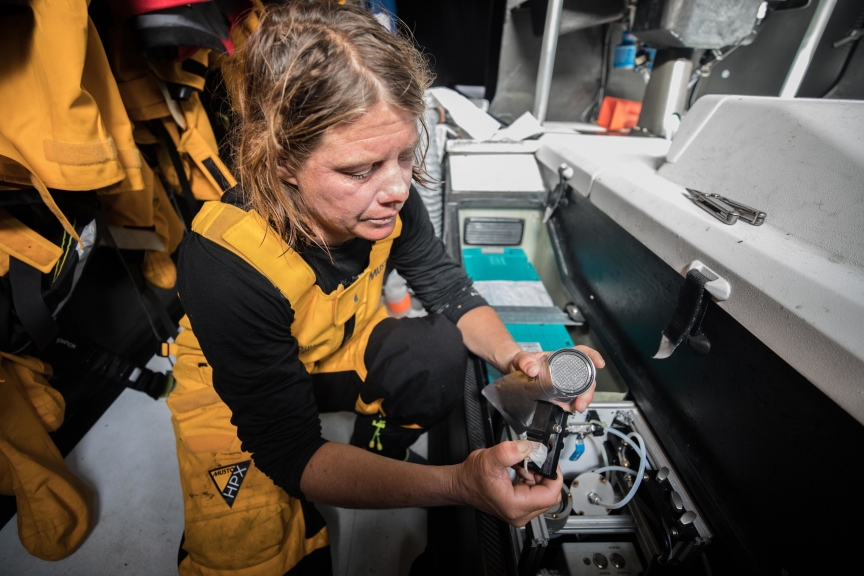Legacy
What does Volvo Ocean Race leave in our wake?Find out about our science programme.
The world's oceans are the lifeblood of the Volvo Ocean Race, and as such we know that their future is in all our hands.
That's why we did everything we could to inspire sailors, race fans around the world, partners, stakeholders, host cities and sponsors to join us in our quest for cleaner seas.
Our vision is that through our sustainability programme we can use the race's global presence to raise awareness of the very serious threat of plastic pollution.
We engaged with our millions of Race Village visitors and vast digital audience around the world to alert them to the issue and inspire them to take action in their lives, their workplaces and within their communities.
We worked with each of the 12 Host Cities, striving to impact, influence and change views during our stays.
But most importantly aimed to create a positive legacy that that saw a lasting change in world attitudes towards ocean health.
At our Ocean Summits we called for action and commitments from local decision makers and business leaders to change the way we behave towards our oceans for good.
____________
Science Programme

Part human adventure and part technological challenge, the 2017-18 Volvo Ocean Race was also a scientific expedition – with a specific mission to gather data that will help make a meaningful difference in the fight against ocean plastic pollution.
Over the course of the 45,000 nautical mile (83,000 km) route, the teams gathered meteorological and oceanographic data as they raced through parts of the globe that are often inaccessible to scientists.
The Science Programme was made possible thanks to the support of Volvo Cars, Kiel Cluster of Excellence - The Future Ocean, our sustainability partners and a scientific consortium including NOAA (National Oceanic and Atmospheric Administration), JCOMMOPS (UNESCO-IOC), GEOMAR and SubCtech.
It was comprised of three elements:
Firstly, all of the racing yachts sent 36 data points back to race control every 10 seconds including temperature, barometric pressure, wind speed and direction. This data was passed on to the National Oceanic and Atmospheric Administration and the European Centre for Medium Range Weather Forecasts. It will contribute to more accurate weather forecasts and climate models.
Secondly, during the four most isolated legs in the race, all seven yachts deployed scientific-drifter buoys equipped with satellite communications equipment to transmit information on ocean composition and currents.
Finally, the Turn the Tide on Plastic and Team AkzoNobel boats, carried instruments onboard to test dissolved CO2, temperature, salinity and Chlorophyll-a (algae) directly in the sea water around them.
These key metrics for ocean health were logged in addition to test trials for microplastics in order to create a snapshot of the world’s ocean along the race route.
A full overview of the Science Programme and results is available to download: 2017-18 Science Programme Final Report
Preliminary Science Data - Alicante to Hong Kong - Legs 1 to 4
Preliminary Science Data - Hong Kong to Auckland - Leg 6
Preliminary Science Data - Auckland to Itajaí - Leg 7
Preliminary Science Data - Itajaí to Newport - Leg 8
Preliminary Science Data - Newport to Cardiff - Leg 9
Preliminary Science Data - Cardiff to The Hague - Legs 10 and 11
Seabin report Auckland stopover.
____________
Young People

Young people play an important role in our sustainability programme, for it is these future generations that must continue our fight against plastic pollution if we are going to succeed in making the ocean healthier.
We invites schools and families to our Race Villages to learn about plastic pollution and what they can do to combat it. We also have an online education programme on Ocean Health and plastic pollution, which can be accessed directly or downloaded and used by educators in their programmes.
____________
Sustainable Event Production

The Volvo Ocean Race offers a unique platform to spread a message of sustainability far and wide as we travelled around the globe, but we also intended to set a benchmark for sustainable practices ourselves. Our sustainability message permeates through every aspect of the Volvo Ocean Race, working to minimise the footprint of the Race Village, of the permanent and touring Boatyard, and of Race Teams, and partner activations.
We engaged with Host Cities, stakeholders and suppliers at each stopover to ensure our event was staged with the least impact on the planet as possible. That means conserving water and energy, avoiding single-use plastics where at all possible and only using ethically and sustainability-sourced materials, products and food throughout our operations.
- View our Sustainability Strategy
- View our Sustainability Progess Update (Summary)
- View our Sustainability Progess Update (Full Report)
- View our Sustainability Report
Turn the Tide on Plastic at Sporting Events - User Guide

From local playing fields to the world stage, athletes, teams, clubs, events organisers, federations, stadia, spectators and fans are joining forces to turn the tide on plastic. Sporting events can show true leadership by eliminating single-use plastic from their sites and advocating throughout their supply chain and fan base for everyone to play their part in making #CleanSeas a reality.
This guide has been produced to share our knowledge and learnings on how to reduce single-use plastic at sporting events. We hope it inspires you to take action to turn the tide on plastic at your event too.
